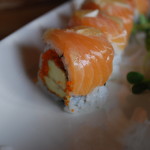
It doesn’t take a genius to know that sushi is a posh trend that is here to stay. Unfortunately, unless we sushi consumers become more aware of what types of sushi are eco-friendly and which are not, the trend may die out sooner than we think.
The Monterey Bay Aquarium published a “Sushi Guide” and many popular sushi fish are on the list to avoid. The guide urges sushi eaters to find seafood that is sustainably caught or farmed. Eating certain types of sushi is harmful to our Earth, but there are ways of making or consuming sushi that are more sustainable. Just knowing the alternative fish to order is a good start.
Play the Sustainable Sushi game to test your knowledge at http://www.sustainablesushi.net/virtual-sushi-dinner/
The population of one of the most eaten sushi fish, the bluefin tuna, is depleting rapidly. The Monterey Bay Aquarium suggests that consumers order albacore tuna (shiro maguro) instead of bluefin tuna, as “it tastes similar and is a best choice when troll caught in the US or Canada.” This type of fish is also caught using a more environmentally friendly fishing method. The fish are
“troll caught” which means that fishermen use a fishing pole and bait to catch their fish, as opposed to gillnetting (large nets used to catch schools of fish).
Tataki, a sustainable sushi restaurant at 2815 California Street (at Divisadero) strives to “showcase the beauty and delicacy of Japanese cuisine while respecting the sanctity and fragility of our environment.” Elly Fireside-Ostergaard (’12) and I went to Tataki as it opened for dinner at 5:30pm. We immediately noticed The Monterey Bay Aquarium’s Sushi Guide prominently displayed at each table. After some deliberation, we decided to order the “Crispy California Rolls,” deep-fried calamari, the ocean salad, tuna rolls, and the arctic char and avocado rolls.
After dinner we both agreed that the calamari was one of the highlights of the meal; it was lightly fried and had a bit of spice that did not overpower the calamari. We were also immediately drawn to the bright green colors of the ocean salad (cucumber and ocean seaweed with a vinegar dressing). The most impressive of the sushi that we ordered were the crispy California Rolls from the specials menu. These were hand-rolled (not rolled and then cut into pieces) and had all the components of a typical California Roll, topped with crispy tempura flakes. Fireside-Ostergaard raved about the Crispy California Roll, saying, “the crab…had a rich, yet subtle flavor. It was augmented by the smooth texture the avocado provided, and then the crispy tempura flakes on top was a perfect accent.”
There was one dish, however, that was just average: the tuna rolls. Though it was not off-putting, we agreed that the tuna itself was surprisingly bland in comparison to the overwhelming taste of rice and seaweed.
Unfortunately, this restaurant is an anomaly. Most sushi restaurants in San Francisco are not as eco-friendly they should be. However most restaurants do offer alternatives. Meredith Oram, an Urban Spanish teacher, strongly believes that more sushi restaurants should catch on to Tataki’s trend. She says, “if more restaurants participated and ‘greened’ their sushi, it would make more of a difference to our eco-system.”
Oram continued to say, “the issue is very complicated. we are consuming too much fish, so the first suggestion would be to eat less fish. And then when eating fish to choose the greener choice, like Tataki.” Though it is difficult to determine just how much of a difference Tataki is making on our eco-system, “we have to start somewhere,” says Fireside-Ostergaard. She continued on to say, “I love my sushi, and I love my environment…Tataki is a…place where the food tastes good and I don’t feel bad about destroying the environment with my love of sushi.”
If you would like to download the list for yourself, check out the Monterey Bay Aquarium website:
http://www.montereybayaquarium.org/cr/cr_seafoodwatch/sfw_sushi.aspx
If you would like to explore Tataki’s menu, check out their website:
http://www.tatakisushibar.com/index.html

